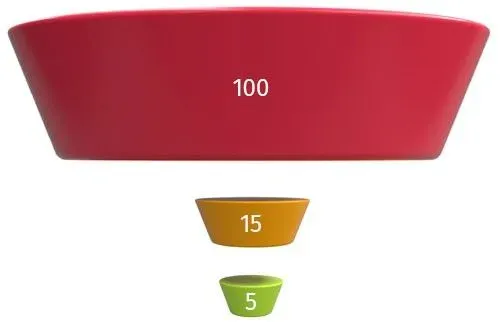In this article, you’ll learn:
If you want to beat the competition, you don’t necessarily have to be bigger or stronger. But you do have to be faster. Optimization is every SaaS company’s secret weapon.
Fine-tuning your SaaS sales funnel is all about getting the most out of the resources you have today. By following the recommendations in this article, you’ll be able to outperform and out-sell the competition, even if they have 10X the staff and millions more in funding. We at Pics.io constantly build and optimize our sales funnel and will share our most valuable insights helping to get the customers you want.
But where do you start?
Design the Simplest SaaS Sales Funnel

Your sales funnel is the backbone of your entire sales process. It’s the path your prospects take from having no idea who you are to becoming happy, paying customers. Yet so many SaaS startups don’t take the time to really understand and optimize their funnel.
Let’s start with the basics. Regardless of what you’re selling, every sales funnel follows the same steps:
- Understand who your ideal customer profile is: Who exactly are you selling to? (Everything else in your sales funnel doesn’t matter if you get this wrong, which is why we spend so much time talking about the importance of customer intimacy)
- Discover where those ideal customers spend their time: Where are they and how can you get in touch with them?
- Qualify them as good leads: Are these actually the right people who will get value from your product or service?
- Convert your qualified leads into customers: Can you successfully sell them on your value?
- That’s the flow you want your customers to go through. But to make it even more clear, you can use a simple framework called the AQC funnel: Activity, Quality, Conversion.
Why Do You Need to Care about SaaS Sales Funnel?
Here’s an example:

Let’s say you’re running a sales calling campaign and you dial 100 prospects, reach 15 of them, qualify only 10, and close 5. In this case, your sales funnel will look like this:
Activity: 100 dials
Quality: 15 reaches and 10 qualifiers
Conversion: 5 closed sales
The reason it’s so important to break down your sales activity into a funnel-like this is that it allows you to see where you need help. Let’s look at our example campaign again, only this time, let’s say we’re only closing 1 customer from every 100 calls.
The problem might seem obvious (you’re not closing enough deals). But without a sales funnel, you don’t have enough information to pinpoint exactly where to experiment and optimize. Maybe you called 100 people, reached and qualified 1, and closed that 1 person. Or, you called 100 people, reached 30, qualified 20, and only closed 1.
As you can see in the first case, your reach rate at the top of the funnel is broken. While in the second, there’s something wrong further along when it comes time to close.
Your goal in both scenarios is to improve your close rate. But, when you have a funnel you can define the problem and fix it.
Examine the Top of the Sales Funnel First
The basic recommendation is to start with the examination of the top of the funnel. Look at your top customers and see what they have in common. What are their shared attributes or qualities? What size is their company? What’s their annual revenue? What’s their job title? Find out as much as you can about them and target them aggressively.
Research the existent customers in your database, investigate how they use your product and take this information into account while targeting similar companies. At this point use cases can be of great help as well. Although they are vendor-generated and, therefore, bias, it gives a prospect a formal structure to assess your product’s pros and cons based on other companies’ experience.
Remember: The better the quality at the top of your funnel is, the better the results will be at the bottom.
There are other stages of the funnel, which require review as well, and we at Pics.io prepared the list of important tips helping you to optimize it.
Use Pics.io 5 Tips to Optimize Your SaaS Sales Funnel
Optimizing your SaaS conversion funnel can help you identify blockages so you reach more prospects, convert more leads, and sell more subscriptions. When you have worked with your sales funnel for some time and identified the target customers, it is a great time for optimization.
Pics.io recommends following these simple tips in the optimization process:

1) Sell to users, not buyers
Find a balance between selling to users and convincing the buyers as they are quite often not the same person.
In Pics.io we do that in several steps:
- Determine the companies in our sectors of interest. We constantly monitor the existing customer base to outline the most prospective sectors among our users. We make a list of companies, including their location & size. Then we find contact people using LinkedIn. In most cases, our target is directors, brand managers, and CMO.
- Focus on the company’s potential challenges, which our product can solve — we have prepared a list of problems that our current customers solved with Pics.io and customize the cold emails for each sector of interest.
- Offer an additional value in your letter — for our prospective customers we prepared Smart File Organizer — the e-book, which helps them to understand how to build efficient file management and find why it is important for their company.
- When we reach the right person who plans to test the program, we offer to schedule a product demo to show the product to the team who will use it in the future and start the free trial.
- In case the potential customers agree to schedule a demo we ask them a number of questions before it starts concerning: what is the nature of the company’s business, who will use the product, what company plans to solve with a DAM solution.
- After the demo call, we send the record to the company to share this information with other teammates and make the final decision. We continue follow-up and further communication until the final conversion.Strategically managing finances is crucial for scaling any SaaS business rapidly. For instance, options like Elite trader funding can provide the necessary resources to fine-tune and expedite your sales process, helping you stay ahead in a competitive market.
This simple approach allows us to verify the qualified leads and determine the team who will use the program in the future and can convince the final buyer in the necessity of the purchase.

2) Look for blockage points and find the reply for each
Optimize the customer acquisition funnel by getting inside customers’ heads to analyze and remove blockage points.
How to do that? Talk to existing customers — find out what worked well for them with your ads, onboarding, demo, the product itself and adjust accordingly.
We recommend in this respect to follow several recommendations:
- Examine your sales funnel and find the place, where the users do not convert. For example, in our case, it can be users who started the trial but have not connected their Google Drive, trial users who do not return after signing in or low response rate on onboarding campaigns.
- For each of the bottleneck, we find the solution. For example, add in-app messages to encourage Google Drive connection, update onboarding emails to show the better value for the customers or send additional guides, which will help customers to better understand how to work with the program.
- Always ask what was wrong — even in case the potential lead decided to choose another solution, it is a great thing to ask what prevented him from choosing Pics.io. This question helps you to improve your product and update it according to the market requirements.
- Always ask what worked well and what could be made better — do not forget to constantly ask for feedback from the existing database. People who use the product can tell you a lot about its advantages and disadvantages. You might find the bottlenecks you have never expected and solve them.

3) Have a smooth transition from one step of the funnel to the other
How to do that? Control your sales pipeline and never leave the users alone with your product.
What we recommend at this point:
- Construct the clear onboarding email campaign — for example, we have the automated email sequence for our prospective users sent through Intercom.
- Customize onboarding campaigns following the customers' actions — for example, we change the email sequence, when customers connect their Google Drive, invite teammates, upload assets to Pics.io or create a website.
- Update HelpCenter regularly and share useful links with users. Each of your customers should be able to quickly get the answer to the question about the program. For this purpose, we at Pics.io have a list of HelpCenter articles with comprehensive instructions for the users.
- Have a clear next action for each lead — For example, when will you follow up with someone if they haven’t gotten back to you yet? Should you schedule a phone call or in-person meeting with someone? When will you schedule that meeting?
Do not forget about CRM — it can become a great tool for using science, not gut, to determine, which leads are sales-ready, taking into account what behavior causes the lead to accelerating through your sales funnel. But don’t stop at your CRM. Plenty of tools enhance sales prospecting, and you’ll need to find the right one for your business.

4) Eliminate all the complexity and shorten your sales cycle.
How to do that? Use the power of now, do not make demos too long, map out the buying process for prospective customers, prepare the guides to simplify the product testing. Also, strive for automation. This will help you keep your contact management & CRM in sync.
From our experience several things work really well:
- Follow-up right after the demo call, answer each question precisely, do not leave the customer for a long time.
- Prepare the guides, which can help them to master your product. For example, we have Pics.io Quick Start Guide, which offers a step-by-step guide to the DAM implementation process.
- Map out the buying process — we build the special document DAM Implementation Roadmap in 5 days, which is suggested as the optimal necessary steps for the successful implementation of the Pics.io DAM solution. After this period the user has enough information to make the purchase decision.
- And finally, make sure your salesperson always asks for the sale :)

5) Introduce the peer review technique into the demo process
How to do that? After each demo call with a prospective customer assign the video record of the demo for a review.
The reviewer has to answer the following questions:
- What was really great in the demo?
- What was misleading?
- Were there any inaccuracies in the process?
- Which questions were not answered?
- What could be done better?
- What should be done exactly the same way the next time?
This technique works really amazing. We, at Pics.io, started from ~12% demo to paid conversion rate, after eleven months of practice we have 65% and this is a great result. At the same time, the perceived value our users get after the demo rose even more.
If you do all of these things, you’re guaranteed to have an incredible SaaS sales machine. But even if you do just one or two, you’ll still be doing more than the competition. The key is to just start. Every small step you take puts you that much closer to leaving your competitors in the dust. And as a piece of final advice — build trusting relations with your customers and they will be more willing to refer others to use your product. Pics.io’s customers are our greatest sales channel. Do not miss a chance to follow our path.
If you enjoyed this story, please click the 👏 button and share it to help others find! Feel free to leave a comment below.
Subscribe for Pics.io 7-day FREE trial right now and get your files organized.



